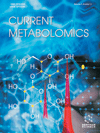- Home
- A-Z Publications
- Current Metabolomics
- Previous Issues
- Volume 3, Issue 2, 2015
Current Metabolomics - Volume 3, Issue 2, 2015
Volume 3, Issue 2, 2015
-
-
Nutritional Metabolomics: Lessons from Companion Animals
More LessThis review describes how metabolomic analysis has been used in support of nutritional research in companion animals, focusing on healthy dogs and cats, and highlights issues that may help those considering metabolomics to support traditional nutritional studies in other mammalian species. Factors that influence the plasma and urinary metabolome in companion animals are known, and include the individual, breed, gender, Read More
-
-
-
Consumption of Cooked Navy Bean Powders Modulate the Canine Fecal and Urine Metabolome
More LessCommon beans (Phaseolus vulgaris, L.), are a safe and digestible source of macro- and micro- nutrients for dogs and supply phytochemicals that are associated with improving human and animal health. In this study, we utilized a targeted and non-targeted metabolomic approach to evaluate dietary cooked navy bean powder (25% weight/weight) as part of the canine food metabolome. GC- and LC-MS were used to evaluate th Read More
-
-
-
Plasma Metabolite Profiling and Search for Biomarkers of Metabolic Dysfunction in Dogs Undergoing Rapid Weight Gain
More LessAuthors: Maria R. C. de Godoy, Kirk L. Pappan, Ryan W. Grant and Kelly S. SwansonThe objective of this experiment was to use untargeted plasma metabolite profiling to identify metabolite changes and potential biomarkers of metabolic dysfunction that accompanies rapid weight gain in dogs. Five intact female beagles were fed ad libitum for a period of 24 wk. Blood samples were collected after an overnight fast via jugular venipuncture at 0, 4, 8, 12, and 24 wk of feeding. Plasma was stored at -80°C Read More
-
-
-
Metabolomics Analysis of Galium odoratum (L.) Scop.: Impact of the Plant Population Origin and Growth Conditions
More LessAuthors: B. Martin, Michel Frederich, P. de Tullio, M. Tits, J. -N. Wauters, Y. H. Choi and M. BodsonIntroduction: Galium odoratum is a plant used in traditional medicine and to prepare beverages. Objective: To study the impact of plant origin and growth conditions on the metabolite content of the plant. Material and methods: Aerial biomass of Galium odoratum was collected from five natural populations (in situ conditions) and from controlled environment (ex situ conditions). NMR-based fingerprinting method was successfully Read More
-
-
-
MALDI Mass Spectrometric Imaging of the Nematode Caenorhabditis elegans
More LessMatrix-assisted laser desorption/ionization mass spectrometric imaging (MALDI-MSI) is a technique that records mass spectra as a function of position across a biological tissue sample, yielding images of chemical distribution. Until now, MALDI-MSI has typically been performed on thinly sliced tissue sections that are coated with a UV-absorbing matrix. We have developed protocols to apply MALDI-MSI to chemically interro Read More
-
Most Read This Month
Article
content/journals/cmb
Journal
10
5
false
en


